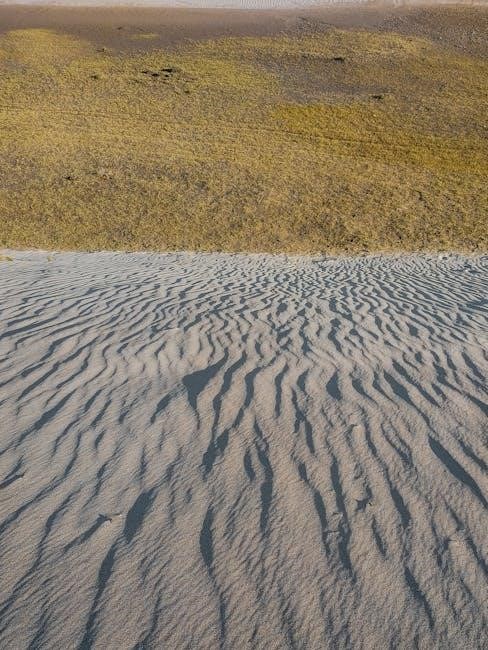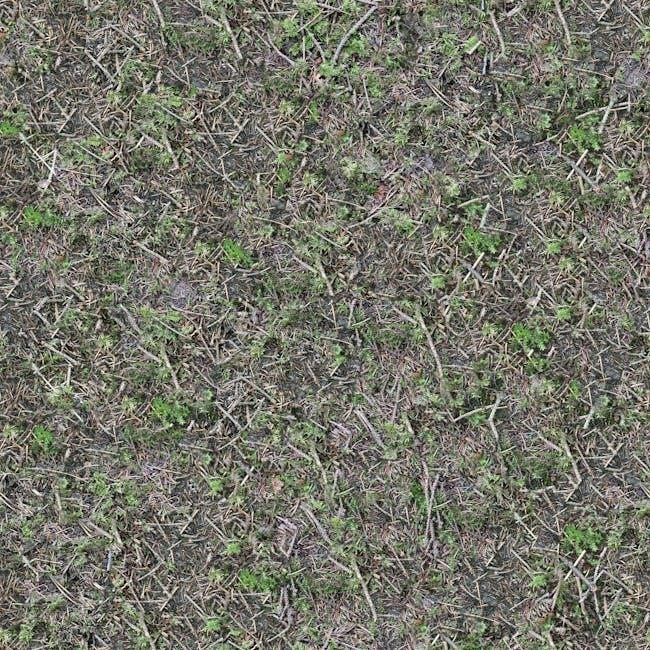munsell soil color chart pdf
The Munsell Soil Color Chart is a standardized tool for identifying and communicating soil colors, organized by hue, value, and chroma․ Widely used in soil science, it provides a precise, scientific approach to color determination, essential for classification and analysis․ Available in PDF format, it remains a cornerstone in agricultural and environmental studies․
Overview of the Munsell Soil Color Chart
The Munsell Soil Color Chart is a standardized tool used globally to identify and classify soil colors․ Organized by hue, value, and chroma, it provides a systematic way to describe soil color․ Each page represents a specific hue, with colors arranged in increasing value (lightness) and chroma (purity) from top to bottom․ Specialized charts for Gley soils are also included to accommodate unique conditions․ The chart contains 322 color chips, making it a comprehensive resource for soil scientists, agronomists, and environmentalists․ Its precision and consistency ensure accurate communication of soil characteristics, making it indispensable for soil classification, agricultural planning, and environmental monitoring․ Available in PDF format, it remains a vital resource for modern soil science applications․
Key Principles of the Munsell Color System
The Munsell Color System is based on three core principles: hue, value, and chroma․ Hue refers to the basic color (e․g․, red, yellow, blue)․ Value indicates lightness, ranging from black (0) to white (10)․ Chroma represents color purity or saturation, from neutral (1) to the most vivid (typically 8)․ These principles allow for precise color identification and communication․ The system is three-dimensional, visualized as a color sphere, with hue arranged horizontally, value vertically, and chroma radially; This structure ensures consistency and accuracy, making the Munsell system a global standard for color description․ Its scientific approach enables uniform color classification, essential for soil science, art, and design applications․ The Munsell Soil Color Chart applies these principles specifically to soils, aiding in their classification and analysis․
History and Development of the Munsell Soil Color Chart

Developed by Albert Munsell in the early 20th century, the Munsell Soil Color Chart was created to standardize soil color identification․ Later revised in 2009 by Macbeth Division of Kollmorgen Instruments, it remains a vital tool in soil science․
Albert Munsell and the Creation of the Munsell Color System
Albert Munsell, an American artist and educator, developed the Munsell Color System in the early 20th century․ Recognizing the need for a standardized method to describe and compare colors, Munsell created a system based on three dimensions: hue, value, and chroma․ This innovation allowed for precise color identification and communication․ Munsell’s work laid the foundation for the Munsell Soil Color Chart, which became essential in soil science․ His system was later refined and adapted for various applications, including soil analysis, ensuring its lasting relevance and widespread use in fields like agriculture and geology․ Munsell’s contribution remains a cornerstone in color science and soil classification․
Evolution of the Munsell Soil Color Chart Over the Years
The Munsell Soil Color Chart has undergone significant revisions since its inception․ Originally developed by Albert Munsell, the chart was later refined to better suit soil science applications․ In 1975, a revised edition introduced new color chips and improved organization, enhancing accuracy for soil classification․ The 2000 edition expanded the chart to include Gley soils, addressing wetland determinations․ By 2009, further updates added more soil-specific colors and standardized notation․ These changes reflect advancements in soil science and the need for precise color communication․ Today, the chart is available in PDF formats, making it accessible for digital use․ Its evolution underscores its adaptability and enduring relevance in soil analysis and environmental studies․
Structure of the Munsell Soil Color Chart
The Munsell Soil Color Chart is structured around three attributes: hue, value, and chroma․ Colors are arranged systematically, enabling precise identification and comparison of soil samples․
Understanding Hue, Value, and Chroma in the Munsell System
In the Munsell system, colors are defined by three dimensions: hue, value, and chroma․ Hue refers to the basic color name, such as red, yellow, or blue, and is arranged in a circle․ Value indicates lightness, ranging from black (low value) to white (high value)․ Chroma represents color purity or intensity, with higher numbers signifying more vivid colors․ Together, these attributes allow for precise color identification, making the Munsell system a robust tool for soil analysis and classification․ This standardized approach ensures consistency and accuracy in describing soil colors, facilitating effective communication among professionals․

Organization of Colors by Hue, Value, and Chroma
The Munsell Soil Color Chart organizes colors systematically by hue, value, and chroma․ Each page represents a single hue, with colors arranged in a grid where value increases vertically from dark to light, and chroma increases horizontally from neutral to more intense․ This structure allows users to locate specific colors by comparing soil samples directly with the chart․ The grid system ensures precise identification, as each color chip corresponds to defined coordinates of hue, value, and chroma․ This method standardizes soil color determination, making it easier to classify and communicate soil characteristics consistently across different studies and regions․
Specialized Charts for Gley Soils
The Munsell Soil Color Chart includes specialized sections for gley soils, which are unique due to their reduced environments and distinct color characteristics․ These charts provide a focused range of colors, often with lower chroma values, to account for the muted tones typical of gley soils․ The organization remains consistent with the main chart, using hue, value, and chroma to categorize colors․ This ensures that users can accurately identify and record the specific shades associated with gley soils, which are crucial for wetland determinations and soil classification․ The inclusion of these specialized charts enhances the versatility of the Munsell system, making it a comprehensive tool for diverse soil types and conditions․
Using the Munsell Soil Color Chart
The Munsell Soil Color Chart enables precise soil color determination by comparing samples with standardized color chips․ It ensures consistent and accurate color analysis for professionals․
Step-by-Step Guide to Determining Soil Color
To determine soil color using the Munsell Soil Color Chart, follow these steps:
- Prepare the Soil Sample: Crush the soil to ensure uniformity and place it on a neutral background to avoid color interference․
- Select the Appropriate Chart: Choose the chart corresponding to the soil type, such as the Gley Soil Chart for wetland soils․
- Compare the Sample: Match the soil sample to the closest color chip by evaluating hue, value, and chroma under natural light․
- Record the Munsell Notation: Document the soil color using the Munsell notation format (e․g․, 5YR 4/6), which represents hue, value, and chroma․

This method ensures precise and consistent soil color identification, essential for scientific and agricultural applications․
Comparing Soil Samples with Munsell Color Chips
Comparing soil samples with Munsell color chips involves matching the soil’s color to the closest chip on the chart․ Start by breaking down the soil to ensure uniformity․ Place the sample on a neutral background to avoid color interference․ Under natural light, align the soil with the chart, focusing on hue, value, and chroma․ Use the grid layout, which organizes colors systematically, to narrow down the match․ For accuracy, ensure the soil is moist, as dry samples may appear lighter․ Specialized charts, such as those for Gley soils, may be needed for specific conditions․ This visual comparison provides a reliable method for consistent soil color identification, critical for scientific and field applications․
Recording Soil Color Using Munsell Notation
Munsell notation provides a precise method for documenting soil color, using a three-dimensional system․ Each color is recorded as a combination of hue, value, and chroma․ Hue refers to the basic color (e․g․, 10R, 7․5YR), value indicates lightness (on a scale of 1-8), and chroma represents saturation (also 1-8)․ For instance, a soil might be noted as 7․5YR 5/4; This system ensures consistency and clarity in communication․ When using the chart, match the soil sample to the closest chip, then record the corresponding notation․ Specialized Gley charts may be used for unique soil conditions, adding prefixes like ‘G’ or ‘GY’ to the notation․ Accurate recording is essential for soil classification and analysis, making the Munsell system a benchmark in scientific and agricultural applications․
Applications of the Munsell Soil Color Chart
The Munsell Soil Color Chart is widely used in soil science, agriculture, and environmental monitoring for accurate soil characterization and classification, aiding in research and land management․
Role in Soil Science and Classification
The Munsell Soil Color Chart plays a pivotal role in soil science by providing a standardized method for identifying and categorizing soil colors․ It enables scientists to classify soils based on their hue, value, and chroma, which are critical for understanding soil properties and behavior․ This system is essential for soil taxonomies, such as the USDA’s Soil Taxonomy, and aids in mapping and analyzing soil distributions․ By offering a consistent framework, the chart facilitates precise communication among researchers and professionals․ Its applications extend to agricultural planning, environmental monitoring, and wetland determinations, making it an indispensable tool in soil science and related disciplines․ The chart’s precision ensures accurate soil characterization, which is vital for sustainable land management and ecological studies․
Use in Agriculture and Environmental Monitoring
The Munsell Soil Color Chart is widely utilized in agriculture and environmental monitoring to assess soil health and fertility․ By accurately identifying soil colors, farmers and researchers can determine nutrient levels, organic matter content, and moisture conditions․ This information is crucial for optimizing crop yields and implementing sustainable agricultural practices․ In environmental monitoring, the chart aids in detecting soil degradation, erosion risks, and pollution effects․ Its standardized color coding ensures consistent data collection, enabling comparisons over time and across regions․ Additionally, the chart’s portability and ease of use make it a valuable tool for fieldwork, supporting informed decision-making in land management and conservation efforts․ Its applications extend to monitoring wetlands and other ecosystems, ensuring precise and reliable environmental assessments․ The chart’s role in these fields underscores its importance in maintaining soil and environmental health globally․
Applications in Geology and Wetland Determinations
The Munsell Soil Color Chart is instrumental in geological studies for identifying mineral composition and weathering processes․ Geologists use it to classify soil and rock colors, aiding in mapping and understanding geological formations․ In wetland determinations, the chart is essential for assessing hydrological conditions and soil characteristics․ Soil color provides critical information about organic matter content, oxidation states, and moisture levels, which are vital for defining wetland boundaries․ The U․S․ Army Corps of Engineers (USACE) relies on the Munsell system for wetland identification, ensuring accurate and consistent classifications․ This tool bridges geological and ecological applications, offering a scientific basis for environmental assessments and land management decisions․ Its precision and reliability make it indispensable in both fields, supporting research and practical applications alike․

Interpretation of Munsell Soil Color Charts
The Munsell Soil Color Chart interprets soil color by analyzing hue, value, and chroma, providing insights into soil properties like organic matter and moisture levels․ It aids in identifying wetland soils and assessing soil health, offering a standardized method for environmental and geological studies․ Digital versions enhance accuracy and accessibility for researchers and professionals․
Understanding the Significance of Color in Soil Analysis
Soil color, as determined by the Munsell Soil Color Chart, reveals critical information about soil composition, organic matter content, and moisture levels․ Darker hues often indicate higher organic matter, while lighter shades may suggest mineral dominance․ Color variations can signal soil degradation or wetland conditions, aiding in environmental assessments․ The Munsell system’s precise notation enables consistent communication among scientists, ensuring reliable data for soil classification and management․ By standardizing color interpretation, it supports accurate ecological and agricultural decision-making, making it an indispensable tool in modern soil science․
Interpreting Hue, Value, and Chroma for Soil Characterization
Hue, value, and chroma are the foundation of the Munsell system, providing a detailed framework for soil characterization․ Hue represents the basic color (e․g․, red, yellow), value indicates lightness or darkness, and chroma reflects color intensity․ In soil analysis, these attributes help identify organic matter levels, moisture, and mineral composition․ For instance, darker values (lower numbers) suggest higher organic content, while lighter values indicate mineral-rich soils․ Chroma variations can signal oxidation states or waterlogging․ By interpreting these components, scientists can classify soils accurately, aiding in environmental monitoring and agricultural planning․ This systematic approach ensures consistency and precision in soil studies, making the Munsell system a vital tool for comprehensive soil characterization․

Digital Versions and PDF Resources
Digital versions of the Munsell Soil Color Chart, including PDF formats, are widely available, offering convenient access for soil scientists and professionals․ The 2009 revision is commonly used․
Availability of Munsell Soil Color Charts in PDF Format
The Munsell Soil Color Charts are widely available in PDF format, offering easy access for soil scientists, agriculturists, and environmental professionals․ These digital versions, such as the 2009 revision, are distributed by authorized sellers and can be downloaded from official sources like the Munsell website․ The PDFs provide high-resolution color chips arranged by hue, value, and chroma, enabling precise soil color identification․ They include detailed diagrams for standard soils and specialized Gley charts․ Professionals often use these PDFs for fieldwork, research, and reporting, as they are portable and compatible with modern devices․ The digital format ensures consistency and accuracy, making it an indispensable tool in modern soil science and environmental monitoring․
Advantages of Digital Munsell Color Charts
Digital Munsell Color Charts offer numerous benefits, including portability and accessibility․ They can be easily downloaded in PDF format and accessed on various devices, making them ideal for fieldwork․ The high-resolution images ensure accurate color representation, crucial for precise soil analysis․ Digital charts eliminate the need for physical storage, reducing bulk and enhancing convenience․ They are also environmentally friendly, minimizing the need for printed materials․ Additionally, digital versions allow for easy updates and revisions, ensuring users always have the most current standards․ This adaptability makes digital Munsell charts a valuable resource for professionals in soil science, agriculture, and environmental monitoring, enhancing efficiency and reliability in their work․

Limitations and Challenges
The Munsell Soil Color Chart has limitations, such as human subjectivity in color perception, requiring trained professionals for accurate identification․ Environmental factors like lighting conditions can affect color accuracy․ The system’s complexity may overwhelm novice users, necessitating extensive training․ Additionally, the physical charts are bulky, while digital versions depend on screen calibration for accuracy, posing challenges in fieldwork․ Despite these drawbacks, the Munsell system remains a vital tool in soil science, balancing its limitations with its standardized and precise methodology․
Limitations of the Munsell Soil Color Chart
The Munsell Soil Color Chart has several limitations․ One major constraint is the subjective nature of color perception, which can lead to variability in interpretations among different users․ Proper training is essential for accurate color identification․ Additionally, the chart’s effectiveness is highly dependent on lighting conditions, requiring controlled environments for reliable results․ The complexity of the system, with its nuanced distinctions between hues, values, and chromas, can be overwhelming for inexperienced users․ Furthermore, the physical charts are bulky, making them less convenient for fieldwork․ While digital versions offer portability, they require precise screen calibration to maintain accuracy, introducing another potential source of error․ Despite these challenges, the Munsell system remains widely regarded for its standardized approach to soil color classification․
Challenges in Using the Munsell System
The Munsell system presents several challenges, primarily due to its complexity and subjective nature․ Achieving consistent color identification requires extensive training and experience, as subtle variations in hue, value, and chroma can be difficult to distinguish․ Additionally, the system’s reliance on standardized lighting conditions necessitates controlled environments, which can be impractical in field settings․ The physical charts are bulky, making them less portable for fieldwork․ Digital versions, while more convenient, require precise calibration to ensure accuracy, introducing another layer of complexity․ Furthermore, the nuanced distinctions between colors may lead to discrepancies in interpretation among users, highlighting the need for rigorous standardization and training to maximize the system’s effectiveness․


Comparison with Other Color Systems
The Munsell system differs from other color systems by its unique three-dimensional structure, emphasizing hue, value, and chroma․ Its precision and standardized methodology make it unparalleled in soil science, offering a more comprehensive and reproducible framework compared to simpler or less detailed systems․
Differences Between Munsell and Other Color Systems
The Munsell system stands out for its three-dimensional structure, organizing colors by hue, value, and chroma, unlike simpler, linear systems․ Its unique arrangement allows precise color matching, particularly for soil analysis․ Other systems may lack the same level of detail or scientific rigor, making Munsell superior for soil science applications․ The Munsell charts are also permutations of soil colors, ensuring a systematic approach to identification․ This differentiation makes it a preferred tool for professionals in agriculture, geology, and environmental monitoring․ The availability of Munsell Soil Color Charts in PDF format further enhances accessibility for modern users․ Its adaptability and precision set it apart from other color systems, ensuring its continued relevance in scientific fields․
Why Munsell Remains a Standard in Soil Science
The Munsell Soil Color Chart remains a standard due to its standardized methodology for color identification, ensuring consistency across scientific studies․ Its detailed color chips provide precise matches for soil samples, enabling accurate classification and communication․ The system’s adaptability, including digital versions, enhances its utility in modern soil analysis․ Widely used in agriculture, geology, and environmental monitoring, Munsell’s reliability and comprehensive approach solidify its role as a fundamental tool in soil science․ Its ability to align with diverse applications while maintaining scientific rigor ensures its continued relevance in advancing soil research and management․

Future Developments and Innovations
Future advancements include integrating digital tools and AI for enhanced soil color analysis, enabling faster and more precise determinations․ Technology continues to expand the chart’s applications․
Modern Tools for Soil Color Determination
Modern tools like digital Munsell soil color charts and smartphone apps are revolutionizing soil color analysis․ These tools enable real-time color matching and precise documentation․ By integrating advanced technologies such as deep learning and AI, soil scientists can achieve higher accuracy in color determination․ Digital versions of the Munsell chart allow for easier comparison and sharing of data, making fieldwork more efficient․ Innovations like mobile apps with camera-based color analysis are particularly useful for on-site soil assessments․ These tools not only enhance the traditional Munsell system but also expand its accessibility and utility in various scientific and agricultural applications․ The integration of technology ensures that soil color determination remains accurate and efficient in modern workflows․
The Role of Technology in Advancing Soil Color Analysis
Technology has significantly enhanced soil color analysis by providing innovative tools that complement the Munsell system․ Digital versions of the Munsell Soil Color Chart, available in PDF formats, offer portability and ease of use․ Smartphone apps equipped with cameras and AI algorithms enable real-time color matching, reducing the need for physical charts․ Additionally, deep learning techniques are being explored to predict soil colors from images, improving accuracy and efficiency․ These advancements not only streamline the process but also make soil analysis more accessible to a broader audience․ By integrating technology with traditional methods, soil scientists can achieve more precise and consistent results in their research and fieldwork, ultimately contributing to better soil management and environmental monitoring practices․
The Munsell Soil Color Chart remains a vital tool in soil science, offering precise color identification․ Its integration with technology ensures continued relevance and accuracy in modern applications․
Importance of the Munsell Soil Color Chart in Modern Soil Science
The Munsell Soil Color Chart is indispensable in modern soil science for its precise color identification, enabling accurate soil classification and analysis․ It aids in assessing soil fertility, wetland determinations, and environmental monitoring․ By providing standardized terminology, it ensures consistency across global studies․ The chart’s availability in PDF and integration with digital tools enhances accessibility and efficiency․ Its adaptability to modern technology, such as smartphone apps, further solidifies its role in advancing soil science․ This system remains critical for understanding soil properties and supporting sustainable land management practices, making it a cornerstone in agricultural and ecological research․
Future Prospects for the Munsell System
The Munsell System is poised for further innovation, integrating advanced technologies to enhance soil color analysis․ Digital versions and smartphone apps could revolutionize fieldwork, offering real-time color matching and data sharing․ Expanded PDF charts with interactive features may improve accessibility for global users․ Collaboration with GIS and machine learning could deepen soil property predictions and environmental monitoring․ Standardized digital formats will ensure consistency across devices, aiding international research․ Translations into multiple languages could foster global collaboration․ These advancements promise to keep the Munsell System at the forefront of soil science, supporting sustainable land management and ecological research․
